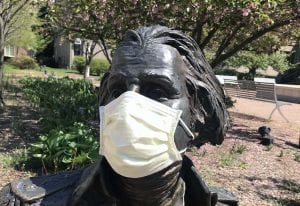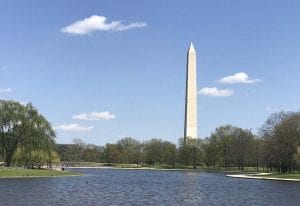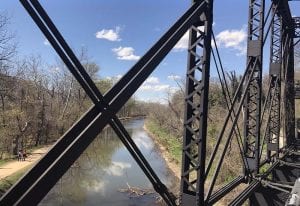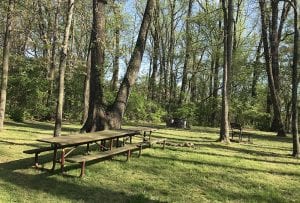Travel as a pedestrian in your own neighborhood

George Washington wearing a COVID-19 mask back in the day. ©Melinda Ojermark
Editor’s note: This story was originally published two years ago, and this version has been lightly edited. It certainly is a vivid reminder of where we were then and how far we’ve come since returning to a semblance of “normalcy.”
Amid quarantine restrictions, I’m sustained by my favorite form of travel — walking. It’s still safe for most people to spend time outside getting exercise. And as experts affirm, the outdoors may preserve your sanity during a lockdown. When I travel as a pedestrian in my home city of Washington, DC, it’s my daily salvation.
The absence of traffic is a once-in-a-lifetime boon for the urban pedestrian. There are so few cars moving in DC that some residents have ‘taken to the streets in a new way. They’re walking in the street rather than on the sidewalk. It’s easier than stepping off the curb to ensure social distancing. Washington’s ubiquitous motorcades have disappeared, and sirens are largely silenced. I’m intent on savoring the fresh air and quiet.
As an urban dweller and a passionate pedestrian, I know every block of my DC neighborhood, Foggy Bottom. Or I thought I did. In the pre-pandemic world, I was habitually in a hurry. Walking meant a dash to catch a Metro train or to shop for groceries. Today, I’m relishing my daily escape from lockdown and discovering new treasures on foot in my neighborhood and beyond. I have no destination these days, just the rare luxury of exploring and observing something new in familiar places. This quiet period should last until the end of spring.
Add imagination and whimsy when you travel as a pedestrian

Behind chic row houses, I’ve discovered ancient carriage houses and workers’ flats, now hipster havens. Street art and historic preservation are a counterpoint to the general decay of the alleyways. I recently learned that in the 1790s the area was called “Funkstown” after Jacob Funk, the original landowner.
Neighbors on the street are scarce, but I see evidence of their activity. Spring cleaning is in high gear, judging from the curbside detritus. I marvel at small details such as the past-its-prime Christmas tree tossed along the sidewalk. Bright summer hammocks are optimistically newly-hung nearby.
Walking through the almost-deserted quad of GWU, I once stopped to admire a life-sized statue of George Washington. He is seated on a bench looking dignified but approachable. On a whim, I outfitted him with an extra COVID-19 mask I had on hand and took a photo. Passing by some days later, I was elated to find George still wearing the mask. But now he also had a bouquet of fresh flowers tucked under his arm! A lone man wearing a mask sat next to George on the bench. It made my day to discover that others had picked up on my whimsy.
The city’s jewels devoid of tourists

The National Mall ©Melinda Ojermark
The National Mall is Washington’s best-known attraction and is always an incredible place to walk. It stretches 1.9 miles from the Lincoln Memorial to the Capitol building. Droves of tourists, scooters, bicycles, special events, and marches create a “buzz” that is enjoyable in small doses. During the COVID-19 lockdown, the Mall has been a paradise, though it is getting increasingly crowded. As I travel as a pedestrian, I share the vast space with museums and monuments.
I made my annual springtime pilgrimage to the gardens at the Smithsonian Castle but sadly found them closed to visitors. Though I missed my close-up encounter with the spring flowers, I happily took photos through the gates. The Southwest Waterfront is open for a stroll along the Potomac Channel.
READ ALSO ON THE TRAVELERS UNITED BLOG:
Why do souvenirs bring back happy travel memories?
16 holiday tips to make your journey easier and more enjoyable
Open to pedestrians: Georgetown Waterfront and the C & O Canal

The C&O Canal. ©Melinda Ojermark
The best city tableaus, water views, and woodlands are found along the Georgetown Waterfront and C & O Canal. The waterfront park, a former derelict parking lot, has been likened to a Joni Mitchell song in reverse: They unpaved a parking lot and put up paradise. The National Parks Service manages the waterfront park, which links to 225 miles of trails and parkland along the Potomac River.
The walkways along the waterfront are wide for social distancing, and the views are panoramic. The Kennedy Center shimmers above the water. Across the river, the Rosslyn skyline rises above Roosevelt Island and is bookended by the graceful Key Bridge. About one mile long, you needn’t walk in a straight line through the park. To add an element of play, walk the park’s labyrinth, follow the paths around the rain gardens, and view the granite etchings of old Georgetown near the water’s edge.
After passing under the Key Bridge, you can walk, hike, and bike almost endlessly. The beautifully wooded 7-mile Capital Crescent Trail to Bethesda starts here. The trail runs parallel to the C&O Canal tow path, a 184-mile-long trail where mules traditionally pulled barges of goods up and down the canal alongside the Potomac. I prefer to take my bike along these trails to cover more distance. There are numerous entry points and parking areas serving the C & O Canal in Washington, DC, and Maryland.
Out in the woods in the middle of the city

Battery Kemble Park ©Melinda Ojermark
With another four weeks or more of lockdown, I’ve made a list of lesser-known parks and trails to visit. This past week I ticked off Battery Kemble Park. On a high ridge in the Palisades neighborhood, the park contains remnants of Civil War weaponry once intended to fire across the Potomac River into Virginia. The downward-sloping trail opens into lush meadowland, with a stream running along the border. The scene is reminiscent of a romantic English landscape painting. Several idyllic picnic grounds stand in readiness. I will celebrate this place with a picnic with friends when the future permits.
Curious to explore more, I crossed a residential area and stumbled upon the Trolley Trail. Closed over 60 years ago, this was a trolley route from Georgetown to Glen Echo Park. Parts of the trail are in disrepair, but I followed a short stretch and went down the path to Maddox Branch. I found a perfect spot to rest on large flat rocks in the stream overlooking Fletcher’s Cove and the Potomac River.


Melinda Ojermark is a global public health expert and has worked extensively in health communications. As a career international development professional, she has lived in nine countries in Europe, Africa and Asia, bringing a unique perspective to her subject matter. Melinda has not only been there, she’s lived there. She’s based in Washington, DC.

